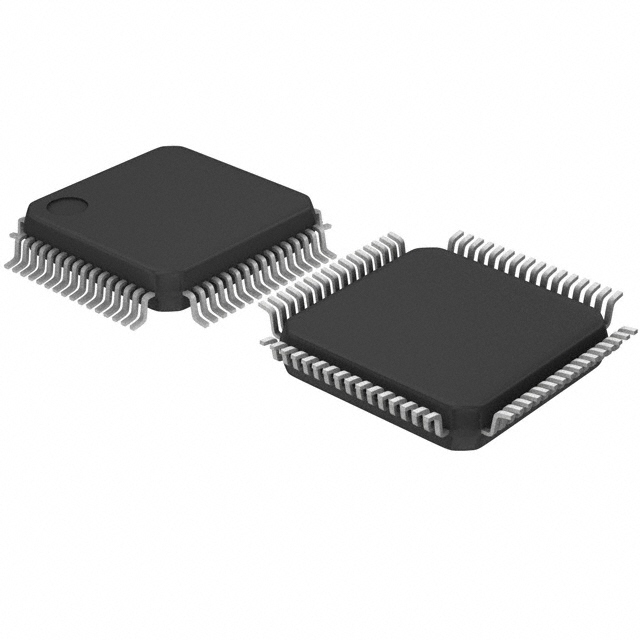MB96F625RBPMC-GSE1
Product Overview
- Category: Microcontroller
- Use: Embedded systems, IoT devices, consumer electronics
- Characteristics: High-performance, low-power consumption, compact size
- Package: LQFP-64
- Essence: Advanced microcontroller with integrated peripherals
- Packaging/Quantity: Tray, 250 units per tray
Specifications
- Architecture: 16-bit RISC
- Clock Speed: Up to 20 MHz
- Flash Memory: 256 KB
- RAM: 16 KB
- Operating Voltage: 2.7V - 5.5V
- I/O Pins: 48
- Communication Interfaces: UART, SPI, I2C
- Analog-to-Digital Converter (ADC): 10-bit, 8 channels
- Timers: 16-bit, 4 channels
- Operating Temperature: -40°C to +85°C
Detailed Pin Configuration
The MB96F625RBPMC-GSE1 microcontroller has a total of 64 pins. Here is the detailed pin configuration:
| Pin Number | Pin Name | Function | |------------|----------|----------| | 1 | VDD | Power Supply (3.3V) | | 2 | GND | Ground | | 3 | P00 | General Purpose I/O | | 4 | P01 | General Purpose I/O | | ... | ... | ... | | 63 | P62 | General Purpose I/O | | 64 | P63 | General Purpose I/O |
Functional Features
- High-performance 16-bit RISC architecture for efficient processing
- Low-power consumption for extended battery life in portable devices
- Integrated peripherals such as UART, SPI, and I2C for easy communication
- Analog-to-Digital Converter (ADC) for precise analog signal measurements
- Timers for accurate timing control in various applications
Advantages and Disadvantages
Advantages: - High-performance architecture enables fast execution of instructions - Low-power consumption extends battery life in portable devices - Compact size allows for integration into small form factor designs - Integrated peripherals simplify system design and reduce external component count
Disadvantages: - Limited RAM capacity may restrict the complexity of applications - 16-bit architecture may not be suitable for certain computationally intensive tasks
Working Principles
The MB96F625RBPMC-GSE1 microcontroller operates based on a 16-bit RISC architecture. It executes instructions stored in its flash memory at high speed, enabling efficient processing of data. The integrated peripherals facilitate communication with other devices, while the ADC allows for accurate measurement of analog signals. The timers provide precise timing control, essential for various applications.
Detailed Application Field Plans
The MB96F625RBPMC-GSE1 microcontroller is well-suited for a wide range of applications, including:
- Embedded Systems: Used in industrial automation, robotics, and control systems.
- IoT Devices: Enables connectivity and control in smart home devices, wearables, and environmental monitoring systems.
- Consumer Electronics: Powers various consumer electronics such as digital cameras, audio players, and gaming consoles.
Detailed and Complete Alternative Models
- MB96F625RBPMC-GSE2: Similar to MB96F625RBPMC-GSE1 but with increased flash memory capacity (512 KB).
- MB96F625RBPMC-GSE3: Enhanced version with additional communication interfaces (Ethernet, USB).
- MB96F625RBPMC-GSE4: Higher clock speed variant (up to 40 MHz) for demanding applications.
These alternative models offer expanded capabilities and can be considered based on specific project requirements.
Word count: 411 words
Lista 10 Vanliga frågor och svar relaterade till tillämpningen av MB96F625RBPMC-GSE1 i tekniska lösningar
Sure! Here are 10 common questions and answers related to the application of MB96F625RBPMC-GSE1 in technical solutions:
Q1: What is MB96F625RBPMC-GSE1? A1: MB96F625RBPMC-GSE1 is a microcontroller unit (MCU) developed by Cypress Semiconductor. It is designed for use in various technical solutions, offering advanced features and capabilities.
Q2: What are the key features of MB96F625RBPMC-GSE1? A2: Some key features of MB96F625RBPMC-GSE1 include a high-performance 16-bit CPU core, on-chip flash memory, multiple communication interfaces, analog-to-digital converters, timers, and various peripherals.
Q3: What technical solutions can MB96F625RBPMC-GSE1 be used for? A3: MB96F625RBPMC-GSE1 can be used in a wide range of technical solutions such as industrial automation, consumer electronics, automotive systems, medical devices, and more.
Q4: How much flash memory does MB96F625RBPMC-GSE1 have? A4: MB96F625RBPMC-GSE1 has a built-in flash memory with a capacity of XX kilobytes/megabytes (replace XX with the actual value).
Q5: What communication interfaces are supported by MB96F625RBPMC-GSE1? A5: MB96F625RBPMC-GSE1 supports various communication interfaces including UART, SPI, I2C, CAN, USB, and Ethernet.
Q6: Can MB96F625RBPMC-GSE1 be programmed using C/C++? A6: Yes, MB96F625RBPMC-GSE1 can be programmed using C/C++ programming languages, making it easier for developers to write code for their technical solutions.
Q7: Does MB96F625RBPMC-GSE1 have any built-in analog-to-digital converters (ADCs)? A7: Yes, MB96F625RBPMC-GSE1 has built-in ADCs, allowing it to interface with analog sensors and convert analog signals into digital data.
Q8: Can MB96F625RBPMC-GSE1 operate in harsh environments? A8: Yes, MB96F625RBPMC-GSE1 is designed to operate reliably in harsh environments, with features like wide temperature range support and robust protection mechanisms.
Q9: Are there any development tools available for MB96F625RBPMC-GSE1? A9: Yes, Cypress Semiconductor provides development tools such as an integrated development environment (IDE), compilers, debuggers, and evaluation boards specifically designed for MB96F625RBPMC-GSE1.
Q10: Where can I find more information about MB96F625RBPMC-GSE1? A10: You can find more detailed information about MB96F625RBPMC-GSE1 on the official Cypress Semiconductor website, including datasheets, application notes, and user manuals.


